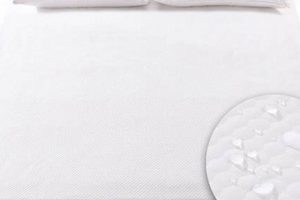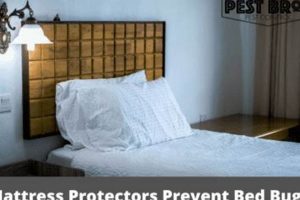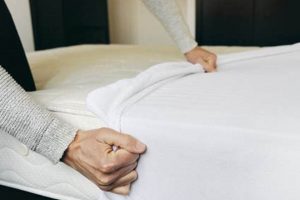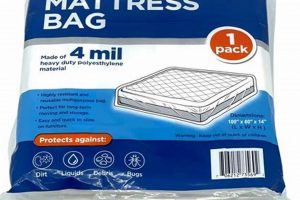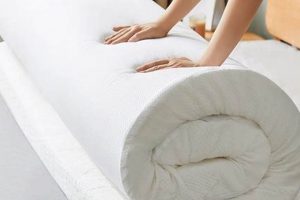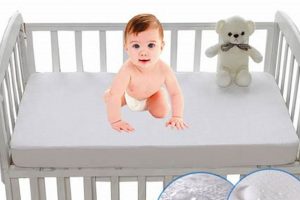A fitted or flat covering designed to safeguard a sleep surface from liquids, allergens, and wear, manufactured with materials cultivated according to regulated agricultural standards, defines a specific product category. These coverings often utilize natural fibers like cotton or wool, grown without synthetic pesticides or fertilizers. For example, a woven cotton barrier intended to shield a bed from spills represents a common iteration of this protective layer.
The utilization of such a barrier offers several potential advantages. Reduced exposure to synthetic chemicals is a primary benefit, appealing to individuals with sensitivities or concerns about indoor air quality. These coverings can also prolong the lifespan of a sleep surface by preventing staining and damage from moisture. Historically, the demand for natural and chemical-free bedding options has driven the development and adoption of these protective measures.
The subsequent sections will delve into the certifications associated with these coverings, examine the various materials used in their construction, and provide guidance on selecting the optimal protector based on individual needs and preferences. Further discussion will address proper care and maintenance to ensure longevity and continued effectiveness.
Guidance on Organic Mattress Pad Protector Utilization
The following recommendations aim to optimize the selection, implementation, and upkeep of a barrier designed to shield a sleep surface. Adherence to these guidelines may enhance the product’s effectiveness and longevity.
Tip 1: Certifications Verification: Prior to purchase, scrutinize certifications such as GOTS (Global Organic Textile Standard) or OEKO-TEX Standard 100. These certifications assure the materials meet established criteria regarding organic content and the absence of harmful substances.
Tip 2: Material Selection Based on Needs: Evaluate material options based on individual sensitivities and requirements. Cotton offers breathability, while wool provides natural moisture-wicking properties. Consider potential allergies to specific materials.
Tip 3: Waterproof Layer Assessment: If waterproof capabilities are desired, examine the type of waterproof layer employed. Polyurethane is a common option, but alternatives like TPU (thermoplastic polyurethane) may offer enhanced breathability.
Tip 4: Fit Considerations: Ensure the chosen barrier is appropriately sized for the mattress. An ill-fitting protector can compromise its ability to provide complete coverage and may lead to premature wear.
Tip 5: Washing Instructions Adherence: Strictly adhere to the manufacturer’s washing instructions. Improper laundering techniques, such as using excessive heat, can damage the materials and diminish protective qualities.
Tip 6: Regular Cleaning Schedule: Establish a consistent cleaning schedule based on usage patterns. Regular washing helps remove allergens, dust mites, and accumulated moisture, thereby maintaining a hygienic sleep environment.
Tip 7: Prompt Spill Management: Address spills immediately to prevent stains and liquid penetration. Absorb excess liquid with a clean cloth before initiating the washing process, if necessary.
Consistent application of these strategies contributes to maximizing the value and performance of a protective covering, safeguarding the sleep surface and potentially enhancing overall well-being.
The subsequent section will provide a detailed overview of available material options and their respective characteristics, enabling informed decision-making.
1. Material Composition
The material composition of a barrier designed to protect a sleep surface fundamentally dictates its performance, durability, and potential impact on user health. Selecting materials cultivated according to organic standards introduces specific considerations regarding sourcing, processing, and performance characteristics.
- Organic Cotton Source and Processing
Organic cotton, a primary material, originates from farms adhering to rigorous standards prohibiting synthetic pesticides and fertilizers. The cotton fibers undergo processing that minimizes chemical treatments, preserving their natural properties. This sourcing and processing directly impacts the final product’s hypoallergenic qualities and reduces potential exposure to irritants.
- Wool Fiber Characteristics
Wool, another common material, offers natural moisture-wicking and temperature-regulating capabilities. The type of wool, whether Merino or other varieties, influences its softness, density, and overall comfort. Processing methods, such as scouring and carbonizing, affect the wool’s purity and potential for allergic reactions. Choosing wool from certified organic sources minimizes the likelihood of chemical residue.
- Waterproof Layer Composition
The inclusion of a waterproof layer necessitates careful material selection. Polyurethane (PU) is a frequently used option, but concerns regarding its breathability have led to the development of alternatives like thermoplastic polyurethane (TPU). The chemical composition of the waterproof layer directly influences its effectiveness in preventing liquid penetration while maintaining airflow. The presence of volatile organic compounds (VOCs) in the waterproofing is also a crucial factor, especially for sensitive individuals.
- Thread and Binding Materials
Beyond the primary fabric and waterproofing, the composition of thread and binding materials also warrants consideration. Opting for organic cotton thread and natural binding agents ensures that the entire product adheres to organic principles, minimizing potential sources of synthetic chemicals. The strength and durability of these ancillary materials contribute to the overall longevity of the mattress pad protector.
The interplay between these material components ultimately determines the effectiveness and benefits of a barrier designed to protect a sleep surface. Prioritizing certified organic materials and carefully evaluating the characteristics of each component contributes to a product that aligns with health-conscious preferences and environmental responsibility.
2. Certification standards
Certification standards serve as a crucial verification mechanism for claims associated with coverings marketed as safeguarding a sleep surface cultivated according to regulated agricultural standards. These standards, often administered by independent third-party organizations, establish criteria encompassing material sourcing, processing methods, and the absence of harmful chemicals. The presence of a recognized certification mark on a protector directly correlates to a higher degree of consumer confidence in its authenticity and adherence to organic principles. For example, a covering bearing the Global Organic Textile Standard (GOTS) certification assures the user that every stage of production, from fiber cultivation to manufacturing, meets rigorous environmental and social standards. This certification minimizes the risk of purchasing a product falsely advertised as cultivated according to regulated agricultural standards. Therefore, certification standards are a necessary component to guarantee that the mattress protector is “organic”.
The practical significance of understanding these certification standards extends beyond mere consumer assurance. Manufacturers who adhere to these standards demonstrate a commitment to sustainable and ethical practices. The certification process often involves regular inspections and audits, ensuring ongoing compliance and accountability. Furthermore, the existence of credible certification bodies drives innovation within the industry, incentivizing the development of materials and processes that minimize environmental impact and promote human health. For instance, manufacturers may opt for water-based printing inks over solvent-based alternatives to meet the stringent requirements of certain certification schemes.
In conclusion, certification standards are fundamental to establishing credibility and trust within the market. They empower consumers to make informed choices and support companies committed to responsible manufacturing practices. Challenges remain in ensuring the consistent application and enforcement of these standards globally. However, the ongoing development and refinement of certification schemes represent a vital step towards promoting a more sustainable and transparent industry for coverings designed to safeguard sleep surfaces.
3. Waterproof capabilities
The integration of waterproof capabilities into a covering designed to protect a sleep surface presents a complex engineering challenge. The primary objective is to prevent liquids from penetrating the protector, safeguarding the mattress from stains, mold growth, and bacterial contamination. However, achieving effective waterproofing often conflicts with the desired properties of breathability and the use of materials cultivated according to regulated agricultural standards. The most common method involves applying a thin layer of waterproof material, such as polyurethane, to the protector’s surface. This layer acts as a barrier, preventing liquids from seeping through. The trade-off is that polyurethane, a synthetic polymer, inherently restricts airflow, potentially leading to increased heat retention and discomfort during sleep. A substandard protector, lacking adequate waterproofing, may result in irreversible damage to the underlying mattress, necessitating costly replacement.
Alternative approaches seek to mitigate these drawbacks. Some manufacturers employ thermoplastic polyurethane (TPU), considered a more breathable and flexible alternative to traditional polyurethane. TPU possesses micropores that allow for some air circulation while still providing a waterproof barrier. Another strategy involves laminating a thin membrane to a fabric layer cultivated according to agricultural standards, such as organic cotton. This lamination process aims to combine the natural breathability of the fabric with the waterproof properties of the membrane. The effectiveness of these strategies depends on the quality of the materials used and the precision of the manufacturing process. Moreover, the durability of the waterproof layer is a critical consideration. Repeated washing and normal wear and tear can degrade the waterproof properties over time, diminishing the protector’s ability to safeguard the sleep surface. For example, a protector repeatedly exposed to high-temperature washing cycles may experience delamination of the waterproof layer, rendering it ineffective.
In conclusion, waterproof capabilities represent an essential function of a covering designed to protect a sleep surface, demanding a careful balance between liquid protection, breathability, and material integrity. While synthetic materials like polyurethane offer reliable waterproofing, they can compromise comfort and sustainability. The pursuit of innovative materials and manufacturing techniques is crucial to developing coverings that effectively protect the sleep surface while minimizing negative impacts on user health and the environment. Continuous research and development are necessary to improve the durability, breathability, and sustainability of waterproof materials used in these protectors.
4. Breathability factors
Breathability, as it relates to a covering intended to safeguard a sleep surface cultivated according to regulated agricultural standards, dictates the degree to which air and moisture vapor can pass through the material. Inadequate breathability can lead to increased body temperature, elevated humidity levels near the skin, and subsequent discomfort, potentially disrupting sleep patterns. The materials utilized in the construction of the covering directly influence this factor. For instance, a protector composed of tightly woven synthetic fibers inherently exhibits lower breathability compared to one crafted from loosely woven organic cotton. The cause-and-effect relationship is evident: denser materials impede airflow, resulting in a less breathable sleep environment. The inverse is also true. The practical significance of prioritizing breathability lies in its potential to enhance sleep quality. A more breathable sleep surface promotes temperature regulation, reducing the likelihood of overheating and promoting a more restful sleep experience.
Real-life examples further illustrate this point. Consider two individuals using seemingly identical sleep surfaces. One utilizes a protector constructed of synthetic materials and experiences frequent night sweats and restlessness. The other utilizes a covering of organic cotton and reports improved sleep quality due to enhanced temperature regulation. This scenario underscores the tangible impact of breathability factors. Moreover, the layering of materials within the protector construction significantly affects overall breathability. A waterproof membrane, while essential for protecting the mattress, can impede airflow. Therefore, manufacturers often employ strategies such as microporous membranes or breathable laminates to mitigate this effect. The effectiveness of these strategies dictates the extent to which the protector can simultaneously provide waterproofing and maintain breathability. The practical application of this understanding involves a careful assessment of material properties and construction techniques when selecting a protector.
In conclusion, breathability factors represent a critical component of a covering intended to safeguard a sleep surface cultivated according to regulated agricultural standards. The materials chosen, construction methods employed, and waterproof capabilities all contribute to the overall breathability of the protector. Prioritizing breathability promotes a more comfortable and restful sleep environment. Challenges remain in achieving optimal breathability while maintaining effective waterproofing and adhering to organic material standards. However, continued innovation in material science and manufacturing processes holds the key to developing protectors that effectively balance these competing demands, ultimately contributing to improved sleep quality.
5. Care requirements
The longevity and efficacy of a covering designed to safeguard a sleep surface cultivated according to regulated agricultural standards are inextricably linked to adherence to specific care requirements. Neglecting these requirements can directly compromise the protector’s intended function, leading to diminished performance and premature degradation. For instance, exposing an organic cotton protector to harsh chemical detergents can strip the natural fibers of their protective oils, reducing its ability to repel liquids and allergens. The cause-and-effect relationship is clear: improper care diminishes the benefits inherently associated with an organic product. The importance of understanding and following care guidelines stems from the inherent sensitivity of materials cultivated according to regulated agricultural standards. These materials often lack the chemical treatments that enhance the durability of conventional textiles, making them more susceptible to damage from improper laundering practices.
Consider the practical example of a wool protector repeatedly subjected to high-temperature washing cycles. The excessive heat can cause the wool fibers to shrink and felt, reducing the protector’s overall size and compromising its fit on the mattress. Furthermore, the felting process diminishes the wool’s natural breathability and moisture-wicking properties. Similarly, using chlorine bleach on an organic cotton protector can weaken the fibers and cause discoloration, reducing its aesthetic appeal and potentially compromising its structural integrity. Adherence to gentle washing cycles, using cold water and mild, plant-based detergents, is essential to preserving the integrity of these materials. The practical application of this understanding involves a careful review of the manufacturer’s care instructions prior to washing or drying the protector. Some protectors may require air drying to prevent shrinkage or damage to the waterproof layer. Additionally, regular inspection for stains or tears is recommended to facilitate prompt repairs and prevent further damage.
In conclusion, care requirements represent a vital component of a covering intended to safeguard a sleep surface cultivated according to regulated agricultural standards. Proper care practices are essential for preserving the protector’s performance, extending its lifespan, and maximizing its intended benefits. Challenges remain in educating consumers about the specific care needs of these products and in developing detergents that are both effective and gentle on organic materials. However, prioritizing proper care contributes to a more sustainable approach to bedding maintenance and ensures the continued protection of the sleep surface. Consistent adherence to recommended washing and drying guidelines will safeguard the integrity and performance of the protector.
6. Size compatibility
The dimensional congruity between a barrier designed to safeguard a sleep surface cultivated according to regulated agricultural standards and the underlying mattress is a critical determinant of its effectiveness. Discrepancies in size can compromise the protector’s ability to provide complete coverage, leaving portions of the mattress vulnerable to spills, stains, and allergens. The cause is straightforward: an undersized protector will inevitably expose areas of the mattress, while an oversized protector may shift and bunch, creating discomfort and reducing its ability to effectively absorb liquids. This directly diminishes the primary function of the protector, which is to shield the sleep surface from potential damage. The importance of selecting a protector that precisely matches the mattress dimensions cannot be overstated, as it directly affects the level of protection afforded.
Consider two analogous scenarios: In the first, a queen-size mattress is fitted with a full-size protector. The resulting gaps along the edges leave the mattress susceptible to spills, rendering the protector largely ineffective. In the second, the same mattress is fitted with a king-size protector. The excess material bunches and shifts during sleep, creating an uneven surface and reducing the protector’s ability to effectively absorb liquids in the event of a spill. These examples highlight the practical consequences of improper size compatibility. From a practical standpoint, accurate measurement of the mattress dimensions, including depth, is essential before purchasing a protector. Many protectors are designed to accommodate mattresses of varying thicknesses, but it is crucial to verify that the chosen protector falls within the specified range. Furthermore, the method of attachment, whether elasticized edges or fitted sheet style, can influence the overall fit and stability of the protector. A poorly fitted protector not only compromises its protective capabilities but can also contribute to premature wear and tear, reducing its lifespan.
In conclusion, size compatibility is a fundamental consideration in the selection of a covering intended to protect a sleep surface. A properly sized protector ensures complete coverage, minimizes shifting, and maximizes its ability to safeguard the mattress from damage. Neglecting this aspect can negate the benefits of even the highest-quality materials and construction. While challenges may arise in accurately measuring mattresses or finding protectors that precisely match non-standard dimensions, the effort is warranted to ensure optimal protection and longevity of the sleep surface. Therefore, the connection of size compatility is vital to ensure the organic mattress pad protector will be useful.
Frequently Asked Questions
The following questions address common inquiries regarding the utilization, care, and selection of coverings designed to safeguard sleep surfaces while adhering to organic standards. The information presented aims to clarify misconceptions and provide a comprehensive understanding of these products.
Question 1: What distinguishes a covering designed to safeguard a sleep surface cultivated according to regulated agricultural standards from a conventional mattress pad protector?
A significant distinction lies in the materials utilized. Coverings marketed as safeguarding a sleep surface cultivated according to regulated agricultural standards employ fibers grown without synthetic pesticides or fertilizers. Conventional protectors may incorporate synthetic materials treated with chemical finishes.
Question 2: How frequently should a covering designed to safeguard a sleep surface cultivated according to regulated agricultural standards be laundered?
Laundering frequency depends on usage patterns and individual sensitivity. Generally, washing every one to two months is advisable. However, more frequent washing may be necessary in cases of spills, heavy perspiration, or allergen sensitivity.
Question 3: Do coverings designed to safeguard a sleep surface cultivated according to regulated agricultural standards offer complete waterproof protection?
Waterproof capabilities vary depending on the specific design. Some protectors incorporate a waterproof membrane, while others rely on tightly woven fabrics to repel liquids. Assess the product specifications to determine the level of waterproof protection provided.
Question 4: Can coverings designed to safeguard a sleep surface cultivated according to regulated agricultural standards be placed in a clothes dryer?
Drying recommendations differ among manufacturers. High heat can damage certain materials, particularly those with waterproof layers. Adherence to the manufacturer’s drying instructions is crucial to prevent premature wear and maintain product integrity.
Question 5: What certifications should one seek when purchasing a covering designed to safeguard a sleep surface cultivated according to regulated agricultural standards?
Certifications such as GOTS (Global Organic Textile Standard) or OEKO-TEX Standard 100 provide assurance regarding organic content and the absence of harmful substances. These certifications indicate that the product meets established environmental and safety criteria.
Question 6: How does the composition of a covering designed to safeguard a sleep surface cultivated according to regulated agricultural standards affect its breathability?
The material composition significantly influences breathability. Natural fibers like organic cotton and wool generally offer better breathability compared to synthetic materials. Breathability is a critical factor in regulating body temperature and promoting comfortable sleep.
In summary, the selection and maintenance of coverings designed to safeguard sleep surfaces cultivated according to regulated agricultural standards require careful consideration of materials, certifications, and care instructions. Adhering to these guidelines ensures optimal performance and longevity.
The subsequent section will explore the economic considerations associated with these products, examining the cost-benefit analysis and potential long-term savings.
Conclusion
This exposition has detailed the multifaceted considerations surrounding the selection, utilization, and maintenance of the organic mattress pad protector. From material composition and certification standards to waterproof capabilities and care requirements, each aspect contributes to the product’s overall efficacy and value. The analyses presented emphasize the importance of informed decision-making when selecting a protector that aligns with individual needs and preferences.
The information provided serves to empower individuals to make responsible choices regarding their sleep environment. Continued research and innovation in the field of organic bedding materials are essential to advancing the performance and sustainability of sleep surface protectors. By prioritizing informed selection and diligent care, individuals can maximize the benefits of an organic mattress pad protector, safeguarding their sleep environment and promoting long-term well-being.


